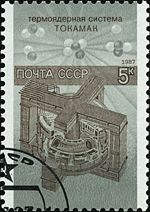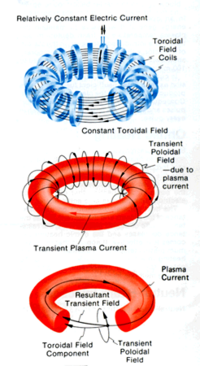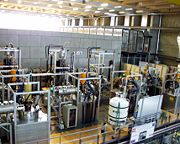Tokamak

A tokamak is a machine producing a toroidal magnetic field for confining a plasma. It is one of several types of magnetic confinement devices, and it is one of the most-researched candidates for producing controlled thermonuclear fusion power.
The term Tokamak is a transliteration of the Russian word Токамак which itself is an acronym made from the Russian words: "тороидальная камера с магнитными катушками" (toroidal'naya kamera s magnitnymi katushkami) — toroidal chamber with magnetic coils (possibly Tochamac). It was invented in the 1950s by Soviet physicists Igor Yevgenyevich Tamm and Andrei Sakharov (who had been inspired by an original idea of "Oleg Lavrentyev").
The tokamak is characterized by azimuthal (rotational) symmetry and the use of the plasma-borne electric current to generate the helical component of the magnetic field necessary for stable equilibrium. This can be contrasted to another toroidal magnetic confinement device, the stellarator, which has a discrete (e.g. fivefold) rotational symmetry and in which all of the confining magnetic fields are produced by external coils with a negligible electric current flowing through the plasma.
Contents |
History
While nuclear fusion research began soon after World War II, the programs were initially classified. It was not until after the 1955 United Nations International Conference on the Peaceful Uses of Atomic Energy in Geneva that programs were declassified and international scientific collaboration could take place.
Experimental research of tokamak systems started in 1956 in Kurchatov Institute, Moscow by a group of Soviet scientists led by Lev Artsimovich. The group constructed the first tokamaks, the most successful of them being T-3 and its larger version T-4. T-4 was tested in 1968 in Novosibirsk, conducting the first ever quasistationary thermonuclear fusion reaction.[1]
In 1968, at the third IAEA International Conference on Plasma Physics and Controlled Nuclear Fusion Research at Novosibirsk, Soviet scientists announced that they had achieved electron temperatures of over 1000 eV in a tokamak device. This stunned British and American scientists, who were far away from reaching that benchmark. They remained suspicious until tests were done with laser scattering a few years later, confirming the original temperature measurements.
Since this performance was far superior to any obtained in their existing devices, most fusion research programs quickly switched to using tokamaks. The tokamak continues to be the most promising device for generating net power from nuclear fusion, reflected in the design of the next generation ITER device.
Toroidal design

Ions and electrons in the centre of a fusion plasma are at very high temperatures, and have correspondingly large velocities. In order to maintain the fusion process, particles from the hot plasma must be confined in the central region, or the plasma will rapidly cool. Magnetic confinement fusion devices exploit the fact that charged particles in a magnetic field feel a Lorentz force and follow helical paths along the field lines.
Early fusion research devices were variants on the Z-pinch and used electrical current to generate a poloidal magnetic field to contain the plasma along a linear axis between two points. Researchers discovered that plasmas confined in a toroidal shape (see figure; top graphic), in which the magnetic lines run parallel to the axis of the toroid, are prone to rapid instabilities and quickly lose confinement. The tokamak and the similar stellarator designs combine a poloidal field (see figure; the center graphic shows the poloidal field) with the toroidal field to stabilize the plasma, making sustained fusion burn feasible. The particles stream parallel (but not perpendicular) to the magnetic field; in a toroidal-poloidal magnetic field, particles twist in a helical path along the toroidal axis (see figure; bottom graphic).
Plasma heating
In an operating fusion reactor, part of the energy generated will serve to maintain the plasma temperature as fresh deuterium and tritium are introduced. However, in the startup of a reactor, either initially or after a temporary shutdown, the plasma will have to be heated to its operating temperature of greater than 10 keV (over 100 million degrees Celsius). In current tokamak (and other) magnetic fusion experiments, insufficient fusion energy is produced to maintain the plasma temperature.
Ohmic heating
Since the plasma is an electrical conductor, it is possible to heat the plasma by inducing a current through it; in fact, the induced current that heats the plasma usually provides most of the poloidal field. The current is induced by slowly increasing the current through an electromagnetic winding linked with the plasma torus: the plasma can be viewed as the secondary winding of a transformer. This is inherently a pulsed process because there is a limit to the current through the primary (there are also other limitations on long pulses). Tokamaks must therefore either operate for short periods or rely on other means of heating and current drive. The heating caused by the induced current is called ohmic (or resistive) heating; it is the same kind of heating that occurs in an electric light bulb or in an electric heater. The heat generated depends on the resistance of the plasma and the current. But as the temperature of heated plasma rises, the resistance decreases and ohmic heating becomes less effective. It appears that the maximum plasma temperature attainable by ohmic heating in a tokamak is 20-30 million degrees Celsius. To obtain still higher temperatures, additional heating methods must be used.
Neutral-beam injection
Neutral-beam injection involves the introduction of high-energy (rapidly moving) atoms into the ohmically-heated, magnetically-confined plasma. The atoms are ionized as they pass through the plasma and are trapped by the magnetic field. The high-energy ions then transfer part of their energy to the plasma particles in repeated collisions, increasing the plasma temperature.
Magnetic compression
A gas can be heated by sudden compression. In the same way, the temperature of a plasma is increased if it is compressed rapidly by increasing the confining magnetic field. In a tokamak system this compression is achieved simply by moving the plasma into a region of higher magnetic field (i.e., radially inward). Since plasma compression brings the ions closer together, the process has the additional benefit of facilitating attainment of the required density for a fusion reactor.
Radio-frequency heating

High-frequency electromagnetic waves are generated by oscillators (often by gyrotrons or klystrons) outside the torus. If the waves have the correct frequency (or wavelength) and polarization, their energy can be transferred to the charged particles in the plasma, which in turn collide with other plasma particles, thus increasing the temperature of the bulk plasma. Various techniques exist including electron cyclotron resonance heating (ECRH) and ion cyclotron resonance heating.
Experimental tokamaks
Currently in operation
(in chronological order of start of operations)
- T-10, in Kurchatov Institute, Moscow, Russia (formerly Soviet Union); 2 MW; in operation since 1975
- TEXTOR, in Jülich, Germany; in operation since 1978
- Joint European Torus (JET), in Culham, United Kingdom; 16 MW; in operation since 1983
- JT-60, in Naka, Ibaraki Prefecture, Japan; in operation since 1985
- STOR-M, University of Saskatchewan; Canada in operation since 1987; first demonstration of alternating current in a tokamak.
- Tore Supra,[2] at the CEA, Cadarache, France; in operation since 1988
- Aditya, at Institute for Plasma Research (IPR) in Gujarat, India; in operation since 1989
- DIII-D,[3] in San Diego, USA; operated by General Atomics since the late 1980s
- COMPASS-D,[4], in Prague, Czech Republic; in operation from 2008, previously operated from 1989 to 1999 in Culham, United Kingdom
- FTU, in Frascati, Italy; in operation since 1990
- Tokamak ISTTOK, [5] at the IPFN - Instituto Superior Técnico, Lisbon, Portugal; in operation since 1991
- ASDEX Upgrade, in Garching, Germany; in operation since 1991
- Alcator C-Mod,[6] MIT, Cambridge, USA; in operation since 1992
- Tokamak à configuration variable (TCV), at the EPFL, Switzerland; in operation since 1992
- TCABR, at the University of Sao Paulo, Sao Paulo, Brazil; this tokamak was transferred from Centre des Recherches en Physique des Plasmas in Switzerland; in operation since 1994.
- HT-7, in Hefei, China; in operation since 1995
- MAST, in Culham, United Kingdom; in operation since 1999
- NSTX in Princeton, New Jersey; in operation since 1999
- EAST (HT-7U), in Hefei, China; in operation since 2006
- KSTAR, in Daejon, South Korea; in operation since 2008
Previously operated
- Texas Turbulent Tokamak, University of Texas, USA; in operation from 1971 to 1980.
- Alcator A and Alcator C, MIT, USA; in operation from 1975 until 1982 and from 1982 until 1988, respectively.
- TFTR, Princeton University, USA; in operation from 1982 until 1997
- CASTOR,[4] in Prague, Czech Republic; in operation from 1983 after reconstruction from Soviet TM-1-MH until 2006
- T-15, in Kurchatov Institute, Moscow, Russia (formerly Soviet Union); 10 MW; in operation from 1988 until 2005
- UCLA Electric Tokamak, in Los Angeles, United States; in operation from 1999 to 2005
- Tokamak de Varennes; Varennes, Canada; in operation from 1987 until 1999; operated by Hydro-Québec and used by researchers from Institut de Recherche en Électricité du Québec (IREQ) and the Institut National de la Recherche Scientifique (INRS)
- START in Culham, United Kingdom; in operation from 1991 until 1998
- COMPASS in Culham; in operation until 2001
Planned
- ITER, in Cadarache, France; 500 MW; first plasma expected in 2018[7]
- SST-1, in Institute for Plasma Research Gandhinagar, India; 1000 seconds operation; currently being assembled[8]
See also
- The section on Dimensionless parameters in tokamaks in the article on Plasma scaling
- Edge-Localized Mode
Notes
- ↑ Great Soviet Encyclopedia, 3rd edition, entry on "Токамак", available online here
- ↑ Tore Supra
- ↑ DIII-D (video)
- ↑ 4.0 4.1 TOKAMAK DEPARTMENT
- ↑ ISTTOK
- ↑ Alcator C-Mod
- ↑ ITER press release June 2008
- ↑ The SST-1 Tokamak Page
References
- Braams, C.M., Stott, P.E. (2002). Nuclear Fusion: Half a Century of Magnetic Confinement Research. Institute of Physics Publishing. ISBN 0-7503-0705-6.
- Dolan, Thomas J. (1982). Fusion Research, Volume 1 - Principles. Pergamon Press. LCC QC791.D64.
- Nishikawa, K., Wakatani, M. (2000). Plasma Physics. Springer-Verlag. ISBN 3-540-65285-X.
- Raeder, J.; et al (1986). Controlled Nuclear Fusion. John Wiley & Sons. ISBN 0-471-10312-8.
- Wesson, John (2000). The Science of JET. http://www.jet.efda.org/documents/wesson/wesson.html.
- Wesson, John; et al (2004). Tokamaks. Oxford University Press. ISBN 0-19-850922-7.
External links
- Plasma Science - site on tokamaks from the French CEA.
- Fusion programs at General Atomics, including the DIII-D National Fusion Facility, an experimental tokamak.
- Fusion and Plasma Physics Seminar at MIT OCW
- Unofficial ITER fan club, Club for fans of the biggest tokamak planned to be built in near future.
- www.tokamak.info Extensive list of current and historic tokamaks from around the world.
- [1] Overview video of a small scale tokamak concept.
- [2] Section View Video of a small scale tokamak concept.
- [3] Fly Through Video of a small scale tokamak concept.
|
|||||||||||